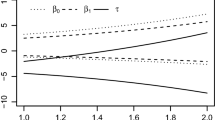Abstract
This paper focuses on model selection in generalized linear mixed models using an information criterion approach. In these models in general, the response marginal distribution cannot be analytically derived. Thus, for parameter estimation, two approximations are revisited both leading to iterative model linearizations. We propose simple model selection criteria adapted from information criteria and based on the linearized model obtained at convergence of the algorithm. The quality of derived criteria are evaluated through simulations.
Similar content being viewed by others
References
Akaike H (1973) Information theory as an extension of the maximum likelihood principle, In: Petrov B, Csaki F (eds), Second International symposium on information theory. Akademiai Kiado, pp 267–281
Akaike H (1974) A new look at the statistical identification model. IEEE Trans Automatic Control 19:716–723
Anderson DA, Aitkin M (1985) Variance components models with binary response: interviewer variability. J R Stat Soc Ser B 47(2):203–210
Bozdogan H (1987) Model selection and Akaike’s information criterion (AIC): the general theory and its analytical extensions. Psychometrika 52:345–370
Burnham KP, Anderson DR (2002) Model selection and multimodel inference: a practical information- theoretic approach, 2nd edn. Springer, Heidelberg
Gaudoin O, Lavergne C, Soler JL (1994) A generalized geometric de-eutrophication software reliability model. IEEE Trans Reliability 43:536–541
Gilmour AR, Anderson RD, Rae AL (1985) The analysis of binomial data by a generalized linear mixed model. Biometrika 72(3):593–599
Harville DA (1977) Maximum-likelihood approaches to variance component estimation and to related problems. J Am Stat Assoc 72:320–340
Kullback S, Leibler RA (1951) On information and sufficiency. Ann Math Stat 22:79–86
Lindstrom MJ, Bates DM (1990) Nonlinear mixed-effects models for repeated measures data. Biometrics 46:673–687
McCullagh P, Nelder JA (1989) Generalized linear models, 2nd edn. Chapman and Hall, London
Pinheiro JC, Bates DM (2000) Mixed-Effects Models in S and S-PLUS. Springer, Heidelberg
Schall R (1991) Estimation in generalized linear models with random effects. Biometrika 78(4):719–727
Searle SR, Casella G, McCulloch CE (1992) Variance components. Wiley, London
Author information
Authors and Affiliations
Corresponding author
Rights and permissions
About this article
Cite this article
Lavergne, C., Martinez, MJ. & Trottier, C. Empirical model selection in generalized linear mixed effects models. Computational Statistics 23, 99–109 (2008). https://doi.org/10.1007/s00180-007-0071-y
Accepted:
Published:
Issue Date:
DOI: https://doi.org/10.1007/s00180-007-0071-y



